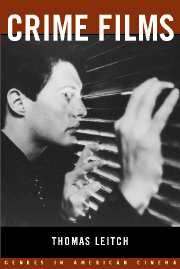Book contents
- Frontmatter
- Contents
- List of Illustrations
- Acknowledgments
- 1 The Problem of the Crime Film
- 2 Historical and Cultural Overview
- 3 Critical Overview
- 4 Fury and the Victim Film
- 5 The Godfather and the Gangster Film
- 6 Double Indemnity and the Film Noir
- 7 Basic Instinct and the Erotic Thriller
- 8 Murder on the Orient Express, Blue Velvet, and the Unofficial-Detective Film
- 9 Chinatown and the Private-Eye Film
- 10 Bullitt and the Police Film
- 11 Reversal of Fortune and the Lawyer Film
- 12 Fargo and the Crime Comedy
- 13 Conclusion: What Good Are Crime Films?
- Notes
- Selected Bibliography
- Filmography/Videography
- Index
2 - Historical and Cultural Overview
Published online by Cambridge University Press: 27 October 2009
- Frontmatter
- Contents
- List of Illustrations
- Acknowledgments
- 1 The Problem of the Crime Film
- 2 Historical and Cultural Overview
- 3 Critical Overview
- 4 Fury and the Victim Film
- 5 The Godfather and the Gangster Film
- 6 Double Indemnity and the Film Noir
- 7 Basic Instinct and the Erotic Thriller
- 8 Murder on the Orient Express, Blue Velvet, and the Unofficial-Detective Film
- 9 Chinatown and the Private-Eye Film
- 10 Bullitt and the Police Film
- 11 Reversal of Fortune and the Lawyer Film
- 12 Fargo and the Crime Comedy
- 13 Conclusion: What Good Are Crime Films?
- Notes
- Selected Bibliography
- Filmography/Videography
- Index
Summary
The roots of the crime film go back far beyond the invention of the movies. Criminals have exercised a particular fascination for the literary imagination whenever social orders have been in flux. Shakespeare's great villains — Aaron the Moor, Richard III, King John, Iago, Edmund, Macbeth — are self-made men who seize opportunities for advancement that would never have arisen in a medieval world whose divinely ordained sense of social order seems to reign, for example, at the beginning of Richard II. Criminals, even if they end up as kings, are precisely those people who overstep the bounds appointed by their status at birth, striving each “to rise above the station to which he was born.” With the waning of the notion that the social and economic status of kings and peasants alike reflect an eternal, God-given order comes the suspicion that some people may be occupying social places they have no right to — a suspicion that produces the rise of the criminal in literature.
Criminals in American literature are as old as American literature itself. The first important novel to appear in the United States, Charles Brockden Brown's Wieland; or, The Transformation (1798), is a supernaturally tinged tale of crime that goes far to anticipate the anxieties of film noir in its sense of gathering doom.
- Type
- Chapter
- Information
- Crime Films , pp. 18 - 51Publisher: Cambridge University PressPrint publication year: 2002



